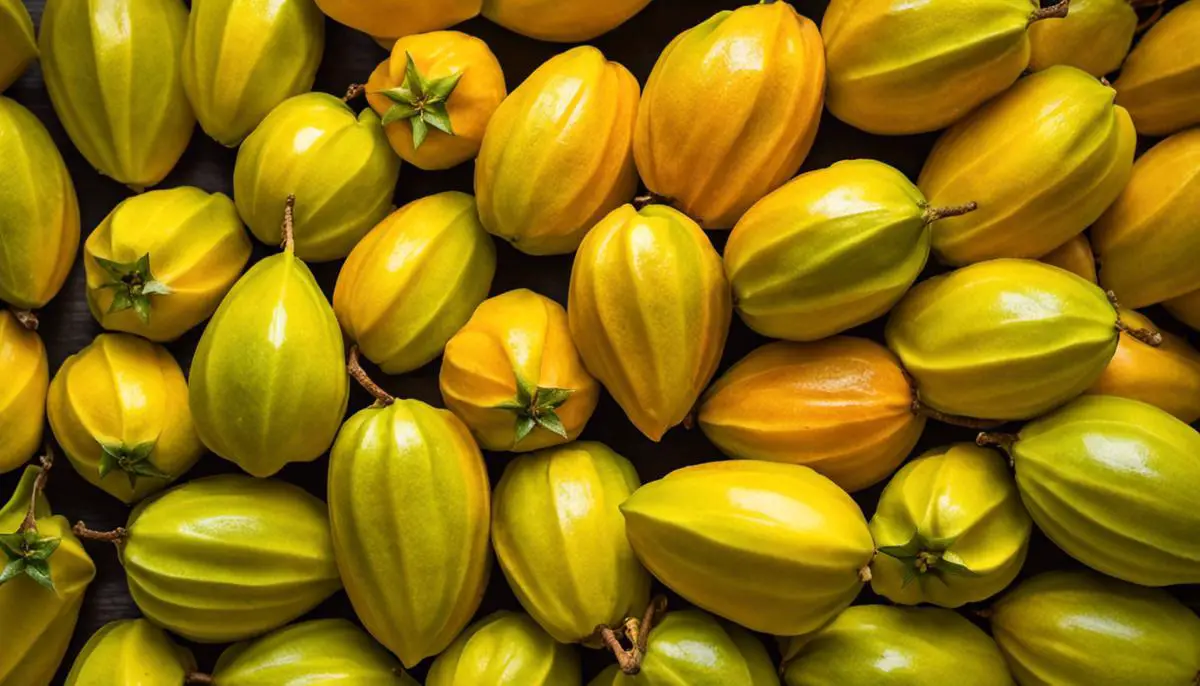With the growing emphasis on health and fitness in today’s society, many people are seeking natural solutions to aid their weight loss journey. Among the plethora of fruits, one that is often underrated yet power-packed with nutrients is carambola, commonly known as star fruit.
Brimming with robust flavors and rich nutritional content, this tropical fruit has gained considerable popularity in the wellness sphere. Originating from Southeast Asia, carambola fruit is a low-calorie, high-fiber food item known for its unique star shape and crisp texture. This essay seeks to delve into the world of carambola fruit, exploring its benefits for weight loss, practical ways to incorporate it into your diet, and the potential precautions to be aware of when consuming it.
Understanding Carambola Fruit
Overview: The Stars Aligned for Healthy Weight Loss with Carambola
Carambola fruit, also known widely as star fruit because of its star-like shape when sliced, is a sweet and sour tropical fruit originally from Southeast Asia but also largely cultivated in areas such as the Caribbean and parts of Latin America. Today, it’s often found in supermarkets around the world, and its consumption has grown among health-conscious individuals due to its potential benefits for weight loss.
Nutritional Content of Carambola Fruit
The star fruit is a low-calorie, nutrient-dense fruit, making it an ideal choice for those looking to shed weight. A 100-gram serving contains just 31 calories and offers a wealth of essential nutrients. It’s rich in dietary fiber, which aids digestion and can make you feel full, curbing excessive eating and snack cravings.
Additionally, it is a great source of vitamin C and is packed with powerful antioxidants, which are beneficial for boosting the immune system and maintaining skin health. It also contains other vital minerals and nutrients such as potassium, zinc, iron, and enzymes that help control metabolism and weight.
Carambola Fruit and Weight Loss
The reason carambola fruit has garnered attention within the fitness and health community is due largely to its potential impact on weight loss journeys. The fruit’s high fiber content helps increase the feeling of satiety and decrease overall calorie intake, which can aid in weight loss.
Moreover, it’s a low-glycemic index fruit, meaning it doesn’t cause rapid spikes in blood sugar levels, which can help in managing overeating. It’s also hydrating due to its high water content, which assists in maintaining adequate body fluid balance and promoting a healthy metabolism.
The carambola is also rich in antioxidants and polyphenolic compounds, such as quercetin, gallic acid, and epicatechin, which research suggests may help boost metabolism and fat burning, potentially helping with weight loss.
Usage and Consumption Tips
Star fruits can be easily incorporated into a diet. It’s often consumed raw, and the entire fruit, including its skin, is edible. It can be sliced and added to salads or used as a refreshing garnish in drinks. Cooking, baking, or making preserves are also popular uses for this versatile fruit. When shopping, choose ones that are firm and bright yellow, as these are ripe and have the sweetest taste.
Do note, however, that despite the potential health benefits, certain individuals, especially those with kidney conditions, should avoid star fruit due to its high oxalic acid content which may interfere with kidney function. Always consult a healthcare provider or dietitian before drastically changing diet or incorporating new foods to a weight-loss routine.
In summary, carambola fruit, with its low calorie, high fiber, and nutrient-packed makeup, serves as a potent ally for those seeking weight loss. The fruit’s unique sweet and sour taste, coupled with its versatility in various dishes, makes it an easy choice to enrich a fruit-heavy diet – a practice always recommended for overall health and wellness.
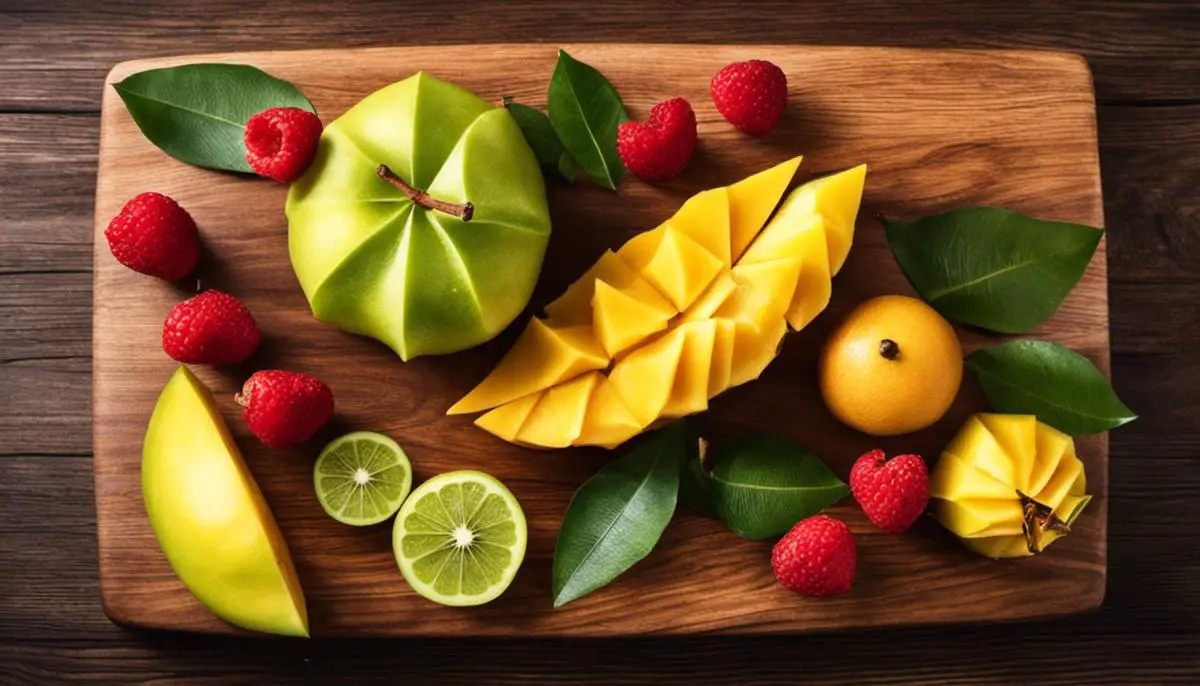
Carambola Fruit and Weight Loss
How Carambola Fruit’s Low Calorie Count Contributes to Weight Loss
Known also as star fruit, carambola fruit boasts an impressively low calorie content, marking it out as a beneficial inclusion in any weight loss diet. To put it into perspective, this distinct fruit carries a mere 31 calories for every 100g – around the weight of a medium-sized fruit. The number of calories consumed each day is a substantial factor in weight maintenance: surplus calories lead to weight gain, while a deficit encourages weight loss. Recognizing this, the low-energy density of carambola becomes particularly attractive as it offers a substantial portion size without the calorie load of more energy-dense foods.
High Fiber Content in Carambola Promotes Satiety
Carambola is a fiber-rich fruit, with around 3g of dietary fiber per 100g. Fiber does not contribute directly to weight loss, but its role in inducing satiety aids weight loss indirectly. Dietary fiber has a unique capacity in promoting feelings of fullness by adding bulk to the diet without contributing significant calories. Consuming fiber-rich foods helps slow down the digestion process, making individuals feel satiated for longer periods of time, thus potentially reducing overall caloric intake.
Carambola’s Role in Maintaining Gut Health
The carambola fruit supports gut health, another indirect way to promote weight loss effectively. Its high fiber levels enhance the gut’s bacterial diversity, promoting the growth of beneficial gut microbes. A well-functioning gut can positively impact overall metabolism, regulate hormones linked to appetite and fat storage, and drastically reduce inflammation — all of which are critical aspects of achieving and maintaining a healthy body weight.
Carambola’s Richness in Antioxidants and Vitamins
Another noteworthy attribute of carambola includes its high concentration of antioxidants and vitamins, which can assist in eliminating toxins, reducing inflammation, and enhancing metabolic function- all vital aspects of weight loss. The fruit is rich in vitamin C, providing 34.4mg per 100g, alongside other antioxidants such as quercetin, epicatechin, and gallic acid. These elements not only contribute to overall health but also support weight loss by boosting metabolism and aiding in the breakdown of fats.
Hydration and Carambola Fruit
Staying hydrated is an essential aspect of weight loss, and carambola’s water content of approximately 91% makes it an excellent choice for maintaining hydration. Proper hydration can aid weight loss by promoting optimal metabolic function and suppressing appetite. Consuming a calorie-free liquid like water before meals has been shown to reduce calorie intake and promote weight loss. Therefore, consuming hydrating foods like carambola may provide similar benefits.
Carambola’s Potential Role as a Natural Diuretic
Carambola can also serve as a natural diuretic due to its potassium content. A diet rich in diuretic foods can help prevent water retention by increasing urine production, which may assist in temporary weight loss. While diuretic-induced weight loss is mostly water weight and not fat loss, it can provide short-term relief from bloating and help individuals feel more comfortable.
While the carambola fruit, also known as star fruit, may not be a magic bullet for weight loss, it’s low calorie content, high fiber, hydration properties, vitamin richness, and gut-health support make it a beneficial addition to a balanced, weight-loss diet. With its unique combination of essential nutrients, this star-shaped tropical fruit can contribute to your overall fitness plan while adding a tangy twist to your meals.
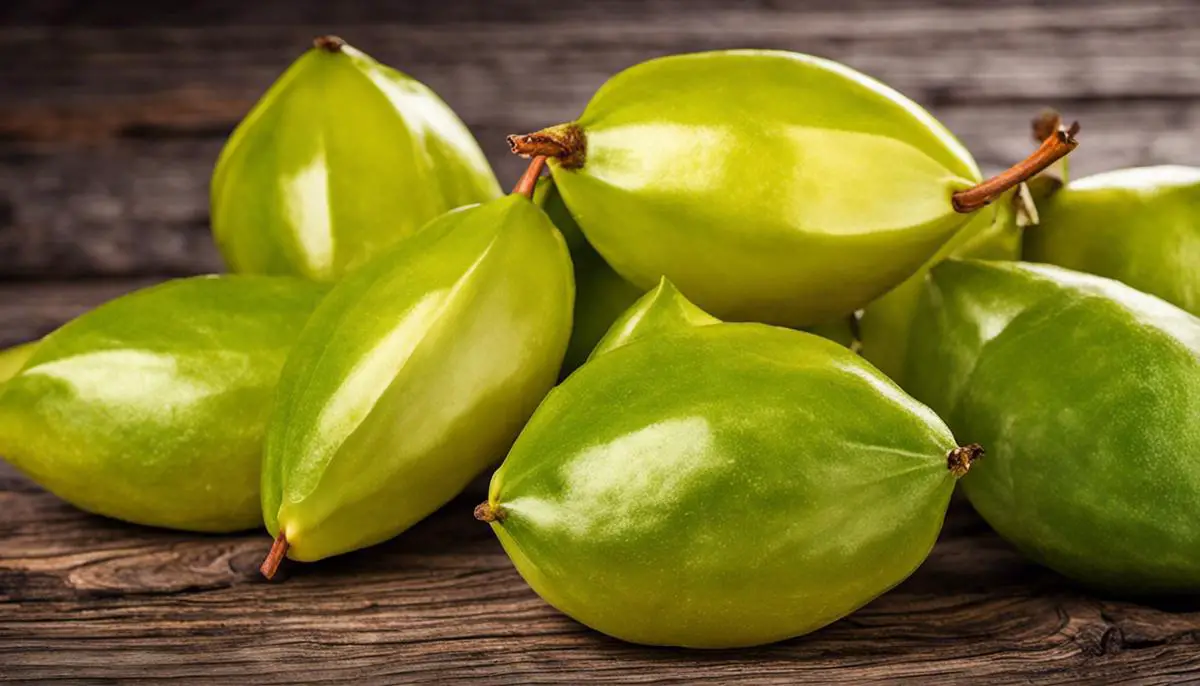
How to Incorporate Carambola Fruit in Diet
Understanding the Nutritional Properties of Carambola
Native to Southeast Asia, carambola is now enjoyed worldwide for its distinctive star shape, bright yellow color, and subtly sour taste. But, more importantly, the fruit shines for its nutritional values: it’s low in calories and high in fiber, vitamins C and A, and antioxidants. It’s the ultimate guilt-free fruit snack, ideal for satisfying sweet cravings and aiding in weight loss.
Incorporating Carambola Into Your Diet
Consuming carambola raw is probably the simplest way to include it in your diet. Whether sliced into salads for a tangy twist, or added to dishes as an edible garnish, raw carambola is a tasty dietary addition. You can also blend it into your morning smoothies, along with other healthful fruits and vegetables, for a balanced, nutrient-packed meal. For something different, try adding carambola to your main dishes – it adds interest to stir-fries and contrasts beautifully with rich meats and fish.
Feeling creative? Try using carambola in your desserts. Since it’s naturally sweet and low in calories, star fruit is a healthier alternative to traditional sugary condiments and toppings.
Try These Carambola Recipes to Aid in Weight Loss
A simple yet delicious recipe that uses carambola as the main ingredient is star fruit citrus salad. Combine slices of carambola with citrus fruits like grapefruit and oranges, drizzle with a little honey or stevia, and sprinkle with some chia seeds for an extra fiber boost.
You can also create a healthy stir-fry with star fruit. Sauté veggies and lean protein such as chicken or tofu, adding carambola last to ensure it retains its crisp texture. Season to taste and enjoy this flavor-packed dish.
Storing the Carambola Fruit
Since it’s a tropical fruit, carambola’s availability may be seasonal and limited to certain regions. However, many grocery stores import these fruits year-round. Look for carambola with a vivid yellow color and a firm, unblemished exterior.
At home, the fruits can be kept at room temperature until fully ripe. After becoming ripe, store them in the refrigerator, where they can last for a week. If you want to extend its shelf life, slice and freeze the carambola. Enjoy the refreshing addition of frozen carambola in your drinks and smoothies.
To sum things up, carambola, with its low calorie count and high nutritional value, is a great addition to any diet. It’s not only supportive in weight loss but can also significantly contribute to overall health and wellbeing.
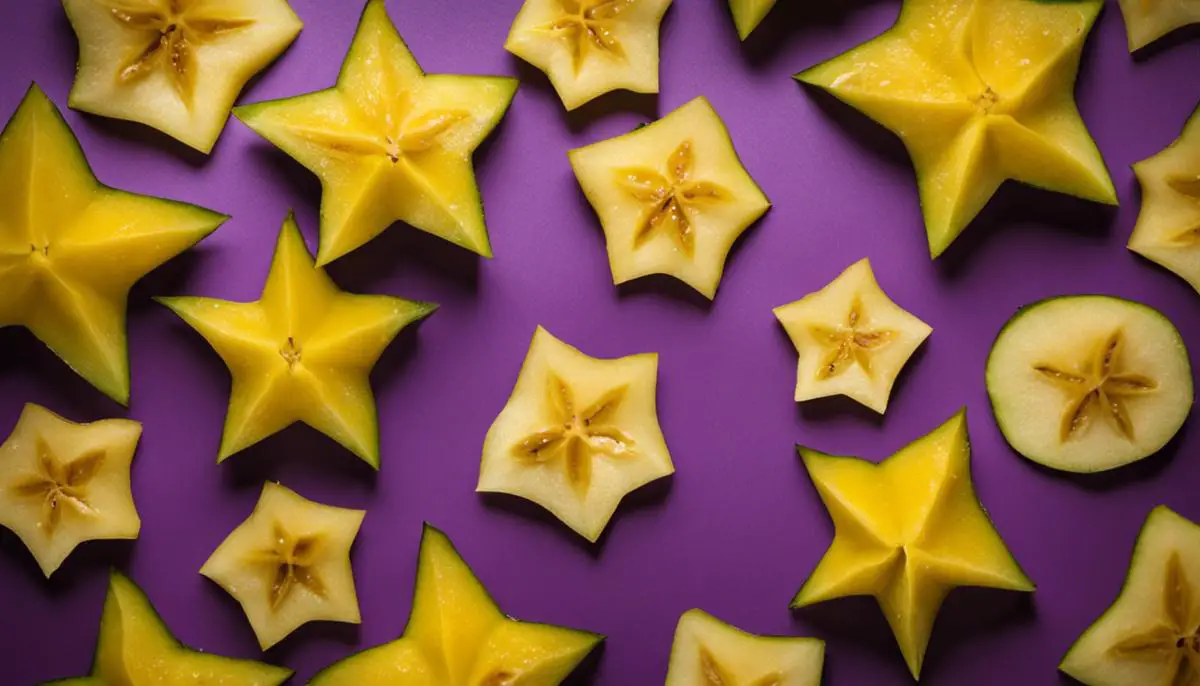
Precautions and Potential Side Effects
Special Consideration: Kidney Health and Carambola Fruit
Due to its low-calorie content and high fiber quantity, the Carambola or star fruit is a great addition to a weight loss regimen. However, it’s important for individuals with kidney conditions to exercise caution when consuming this fruit. Carambola contains a high concentration of oxalates – crystalline substances that can contribute to the formation of kidney stones. For those with compromised kidney function, the body may struggle to process these oxalates efficiently, potentially leading to an increased risk of developing kidney stones.
Potential Side Effects of Carambola Fruit in Your Diet
While carambola fruit boasts several health benefits, especially aid in weight loss, some individuals may experience negative side effects. These can include hiccups, vomiting, nausea, and confusion. Additionally, if consumed in large quantities, carambola can cause diarrhea, due to its high fiber content. Carambola fruit is also known to interact negatively with certain medications, including statins, benzodiazepines, and opiates.
Warning Signs to Seek Medical Advice
When incorporating carambola fruit into your weight loss plan, be mindful of any changes in your physical or mental health. If you experience persistent side effects such as vomiting, nausea, confusion, or unusual pain, it’s crucial to seek medical advice immediately. Those with existing kidney disorders should consult with a healthcare provider before adding carambola to their diet, due to the fruit’s high oxalate content.
People at Risk
People who have been diagnosed with kidney disease, those who have had kidney stones in the past, and individuals who are on medications that carambola can interact with should avoid consuming the fruit. Carambola may also be a risk for people with allergies to the fruit itself or to other plants in the Oxalidaceae family, to which carambola belongs.
Conclusion: Carambola Fruit and Weight Loss
While the carambola fruit can offer numerous health benefits including aiding weight loss, it is essential to consume it mindfully. It is particularly critical for individuals with kidney issues or those on specific medications to consult with their healthcare provider. Remember, while carambola fruit can contribute to a healthy diet, it should be consumed as part of a balanced, nutrient-rich diet for optimal weight loss outcomes.
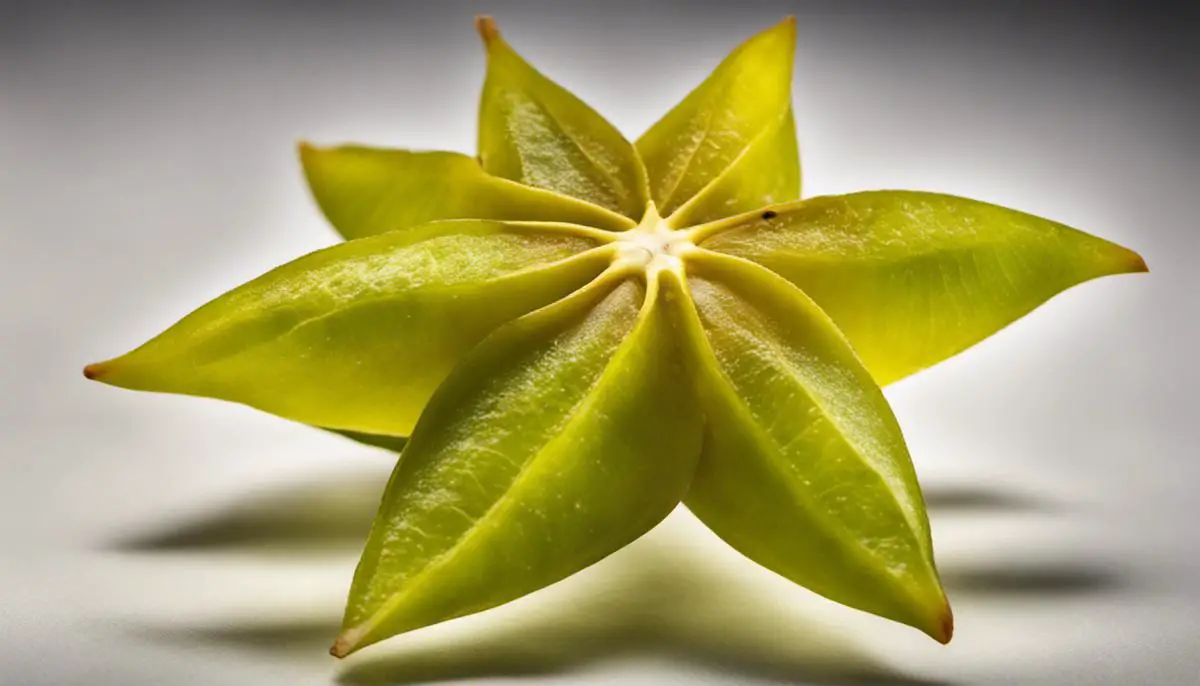
Embracing a balanced diet filled with nutrient-dense foods like the carambola fruit can markedly enhance your weight loss efforts. The tropical fruit’s low calorie content, combined with its high fiber levels, promotes satiety and maintains gut health, assisting you on your path to fitness.
By integrating carambola into your everyday meals, you not only enrich your palate but also fuel your body with vital nutrients. Notwithstanding, it’s crucial to be aware of any possible side effects and seek professional advice when necessary to enjoy the fruit’s benefits safely. After all, thriving health is the ideal blend of conscious eating, exercise, and internal wellness.
